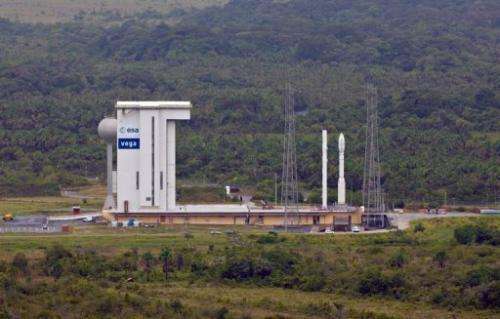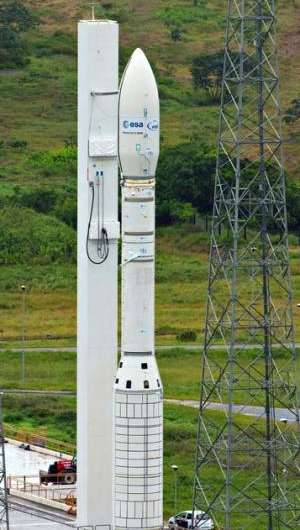Europe stakes billion-dollar bet on new rocket

A pencil-slim rocket is scheduled to lift into space from South America on Monday, carrying a billion-dollar bet that Europe can grab a juicy slice of the market to place satellites in low orbit.
The maiden flight of Vega culminates a decade-long plan to turn Europe's space base in Kourou, French Guiana, into the world's most versatile launch platform.
The launcher 30 metres (100 feet) long and three metres in diameter is designed to hoist loads ranging from 300 kilos (660 pounds) to 2.5 tonnes into orbits from 300 to 1,500 kilometres (187-937 miles) depending on mass.
If all goes well, Vega will complement the heavyweight Ariane 5, capable in its beefed-up version of lifting more than 20 tonnes, and the mid-range Soyuz, the Russian-Soviet veteran deployed to Kourou last year under a deal between Russia and the European Space Agency (ESA).
Vega aims to shoulder its way into a market already teeming with half a dozen existing or would-be competitors, including India, China and Russia -- which is selling launchers using a converted Cold War ballistic missile -- and US commercial firms.
"Vega is a flexible vehicle, with a mission to meet demand for small payloads," said Benoit Geffroy, an engineer at ESA's launchers department.
"The big selling point will be punctuality," he said. Rivals may pitch a lower launch price but then delay their launch, which inflicts hefty indirect costs on a satellite operator, he argued.
Italy has shouldered nearly 60 percent of the 776 million euros (1.008 billion dollars) cost of building the rocket.

ESA members have committed another 400 million euros in launch contracts and other work to guarantee Vega's future.
The rocket is centred on an Italian design that has raised eyebrows for its complexity.
Rocket makers usually try to reduce the number of stages as far as possible to avoid the risk of failure if a stage does not separate or if a motor refuses to ignite.
But Vega uses four stages to propel a small payload into low orbit. The reason: the rocket uses solid fuel, an energy source that cannot be turned on and off as easily as liquid propellant, so having additional stages offers flexibility in swiftly boosting or slowing a flight.
Another innovation, said Carine Leveau of France's National Centre for Space Studies (CNES), is a first stage whose body is made of light-but-tough carbon fibre, a precious gain in the quest for low-cost reliability.
Monday's launch, scheduled for 1000 GMT, is a "qualification" flight with a scientific payload.
Its main satellite, a tungsten sphere called Lares, is designed to study the so-called Lense-Thirring effect -- a strange component of Einstein's theory of general relativity which says that as Earth (or any other big mass) rotates, it drags space and time around with it.
To measure this, Lares is studded with reflectors on which ground-based laser beams will be aimed in order to measure the satellite's time and distance as it zips around the globe.
The other principal satellite, AlmaSat-1, will test new civilian technologies in Earth observation.
The rest of the payload is taken up by seven so-called picosatellites, essentially cubes each weighing less than a kilo (2.2 pounds), in which European universities have each packed a separate experiment.
They include the very first Polish, Romanian and Hungarian satellites, according to ESA.
(c) 2012 AFP




















